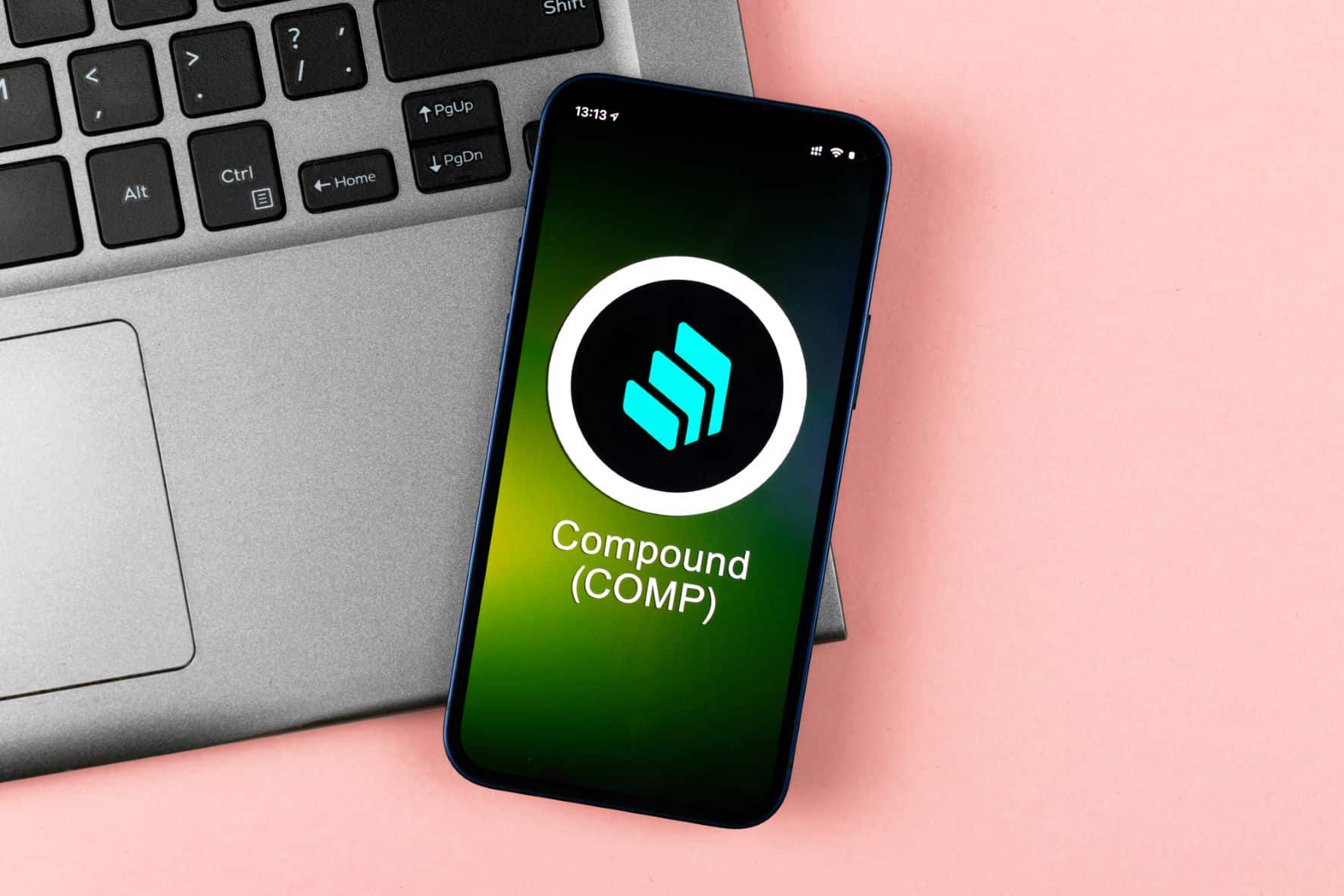Cryptocurrencies have enabled the rise of decentralized finance (DeFi) marketplaces in which monetary transactions are democratized. Compound crypto is a tool for further empowering these marketplaces.
Compound is a protocol that integrates with DeFi networks so that people all over the world can borrow, lend, and save crypto. As a result, crypto owners have the potential to earn interest and maximize their digital investments.

But it’s important to not mistake the Compound protocol with compound interest (though the two aren’t necessarily mutually exclusive). Compound interest is the interest you earn on your interest, while compound crypto is a means for managing crypto investments without an intermediary.
When investing in crypto, it’s crucial to understand the functions and implications of this DeFi protocol. Start with the terminology, then find out how Compound can benefit you through borrowing and lending.
Compound Glossary
Compound Labs, the developer of this Ethereum-based protocol, provides a clear and concise definition of Compound Finance crypto:
“Compound is an algorithmic, autonomous interest rate protocol built for developers, to unlock a universe of open financial applications.”
What this translates to is a series of decentralized interest rate markets through which users supply and borrow Ethereum tokens at algorithm-based interest rates.
Engaging with and profiting from these interest rate markets requires an understanding of the associated terminology. Here’s a glossary of Compound crypto terms to know:
cTokens
cTokens operate on the back-end of the Compound protocol as a means of tracking user funds. These cTokens represent the stake a lender has in the blockchain-based lending pool. With every block, annual interest is recorded and captured.
The user supplies the protocol with cryptocurrency, lending it out on the DeFi marketplace. Then, the protocol gives back a corresponding balance of cTokens.
There isn’t just one kind of cToken, either. The various asset markets all have their own distinct cToken so that lending and interest rate information can be properly tracked. However, all cTokens are also ERC-20 tokens, which means they are created with Ethereum.
Ethereum
Ethereum is both a multi-use software network for enabling smart contract functionality and its own form of cryptocurrency. Though it was built to compliment popular cryptocurrencies like Bitcoin, Ethereum has become a strong competitor in its own right.
The system Ethereum has built makes protocols like Compound possible. Ethereum makes use of a DeFi network and smart contracts to power decentralized applications for crypto trading.
Ethereum is the basis for algorithmic processes that enable Compound crypto price prediction, crypto Compound interest calculators, and the lending pool Compound allows you to draw from.
Lending Pool
The lending pool is the amount of crypto in an interest rate market available for borrowing.
Because Compound tracks these markets with specific cTokens, interest rates fluctuate depending on the size of the individual market. This means your interest rates for loaning to or borrowing from these markets will vary depending on the size of the lending pool.
For instance, if you borrow out of a small pool, your interest rates are going to be higher. Conversely, if you lend to a small pool, the interest you earn will be greater.
Lending pools are essential when determining rates of investment or loan expenses. Fortunately, the DeFi nature of these pools makes them transparent and accessible.
DeFi
Decentralized finance is the umbrella under which virtually all cryptocurrencies fall. With DeFi, financial transactions can be completed over peer-to-peer networks without the need for an intermediary.
This results in the removal of banks and other financial institutions from monetary policy. Cryptocurrency networks operate off independent nodes spread throughout the world to validate transactions that these institutions would traditionally be responsible for.
But DeFi goes even further. Networks like the one built by Ethereum empower all kinds of financial services. Lending and borrowing are only the beginning.
Compound Lending
Ethereum’s DeFi technology makes it easy to lend crypto with many of the coins and interest rates that best suit your needs. Acceptable currencies include:
- Ether (ETH);
- USD Coin (USDC);
- Dai (DAI);
- Wrapped BTC (WBTC);
- Tether (USDT).
All an investor needs to start earning interest is to supply any of these assets into the Compound protocol. You don’t even have to have a complex crypto mining rig, either.
Once you contribute to Compound, you immediately start earning interest. Since Compound operates on the Ethereum blockchain, interest is accrued with Ethereum’s block time. It takes an estimated average of 12 to 14 seconds to mine a new block.
Your assets are exchanged for cTokens, which you can then redeem (principal plus interest) at any time. Though all investments carry some amount of risk, you can always cash out should lending pools grow too large to support a lucrative interest rate.
Use a crypto Compound interest calculator to explore potential gains from an investment, or borrow if you need a loan.
Compound Borrowing
The Compound borrowing process is the other piece of the equation.
To get started, you’ll need crypto as your collateral to borrow against. You use the protocol to lock in your assets, which are then used in place of a credit check. DeFi has the potential to open up financial opportunities even to those with bad credit, though there are limits on what you can borrow.
The Compound protocol algorithm sets borrowing rates based on the “quality” or value of the asset you’re borrowing against. This means that if you’ve locked in $1,000 worth of DAI at a borrowing limit of 40%, you can only borrow $400 worth of other qualifying cryptocurrencies.
You then have to pay interest on what you’ve borrowed. Again, interest is calculated through Ethereum’s block time. However, quoted interest rates are annual, meaning that each 13-second or so accrual will represent only a tiny fraction of the percentage due.
Compound borrowing will be more risky than lending, as it means you’ll have to pay interest rather than earn it. You can only redeem or transfer your collateral after the loan has been repaid.
Additionally, if your borrow balance exceeds your collateral, your account will automatically become insolvent. If this occurs, other users can buy your collateral at an 8% discount rate, and you’ll lose out.
If you believe you can leverage crypto borrowing to your financial success, first check the Open Price Feed as a Compound crypto price prediction tool. Further, take some time to learn how taxes and deductions might apply to your crypto borrowing and lending, along with the factors that affect lending rates.
Factors That Affect Compound Borrowing and Lending Rates
Before you use Compound as a means to diversify your portfolio or borrow against crypto, you should have a thorough understanding of the factors that affect borrowing and lending rates.
While many outside factors may influence the situation, borrowing and lending rates primarily are influenced by three variables:
- Crypto performance: The performance of crypto on the market dictates its value, which in turn affects interest rates.
- Market liquidity: The supply of crypto in a lending pool will increase or decrease the interest rate for lending and borrowing.
- Compound collateral factors: Compound Finance sets the collateral factor rate for individual assets. These rates may change with Compound governance decisions.
If you own COMP tokens, you may have a say in how borrowing rates change. However, most times these factors will be outside your control.
With the proper care and preparation, using the DeFi Compound protocol to earn Compound interest crypto can be a great benefit. You’ll just need attention to detail and a comprehensive understanding of how the protocol works.
How Compound Benefits You
Some of the primary benefits of investing with Compound include:
- Decentralized, bankless financing;
- Earning interest through crypto lending;
- Debtless borrowing potential with collateralized loans;
- Secure and immutable transaction data;
- Diversifiable investment potential with various supported crypto assets.
With a better understanding of Compound, you can set out on your cryptocurrency investment journey for greater financial freedom.




